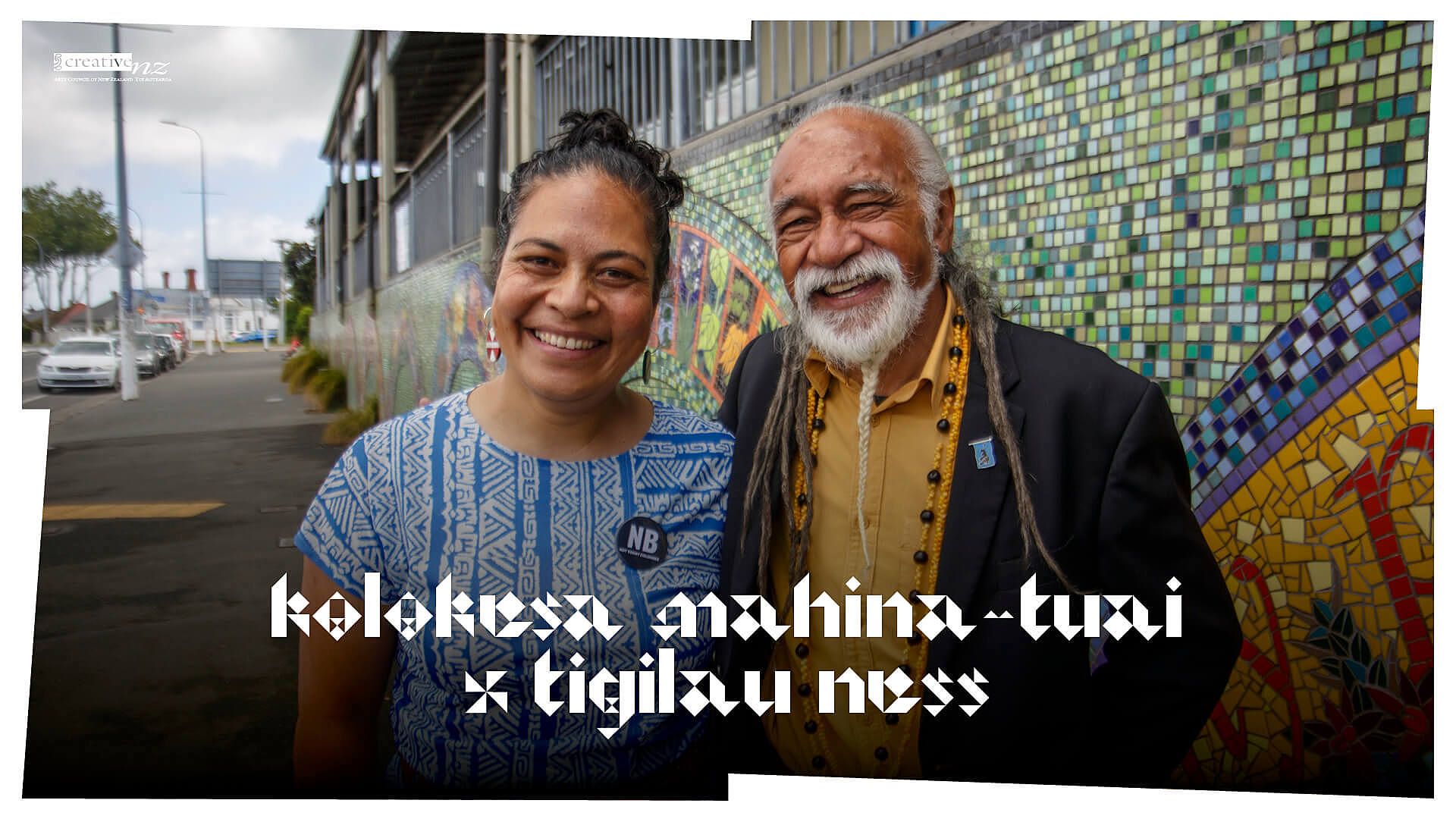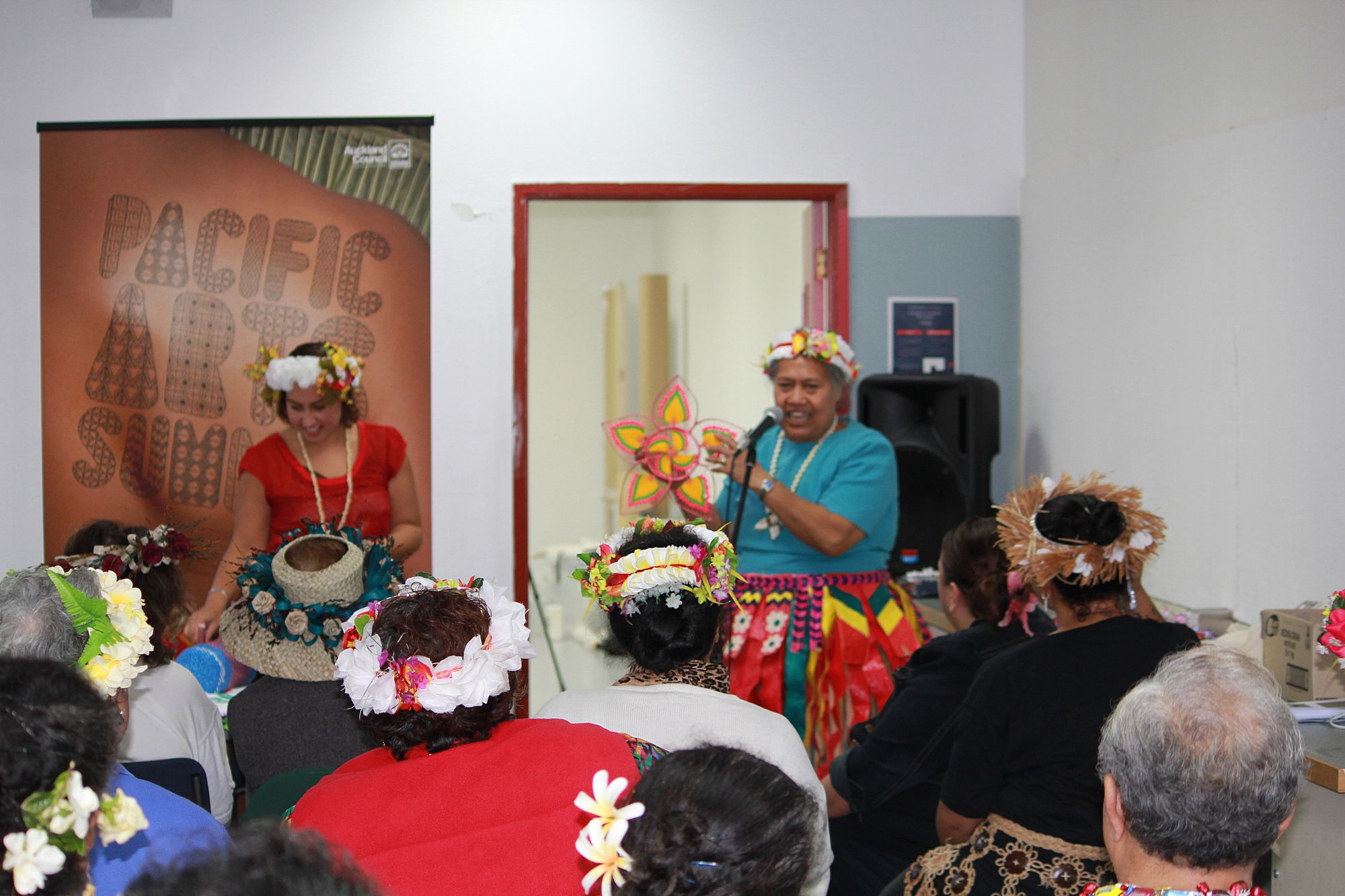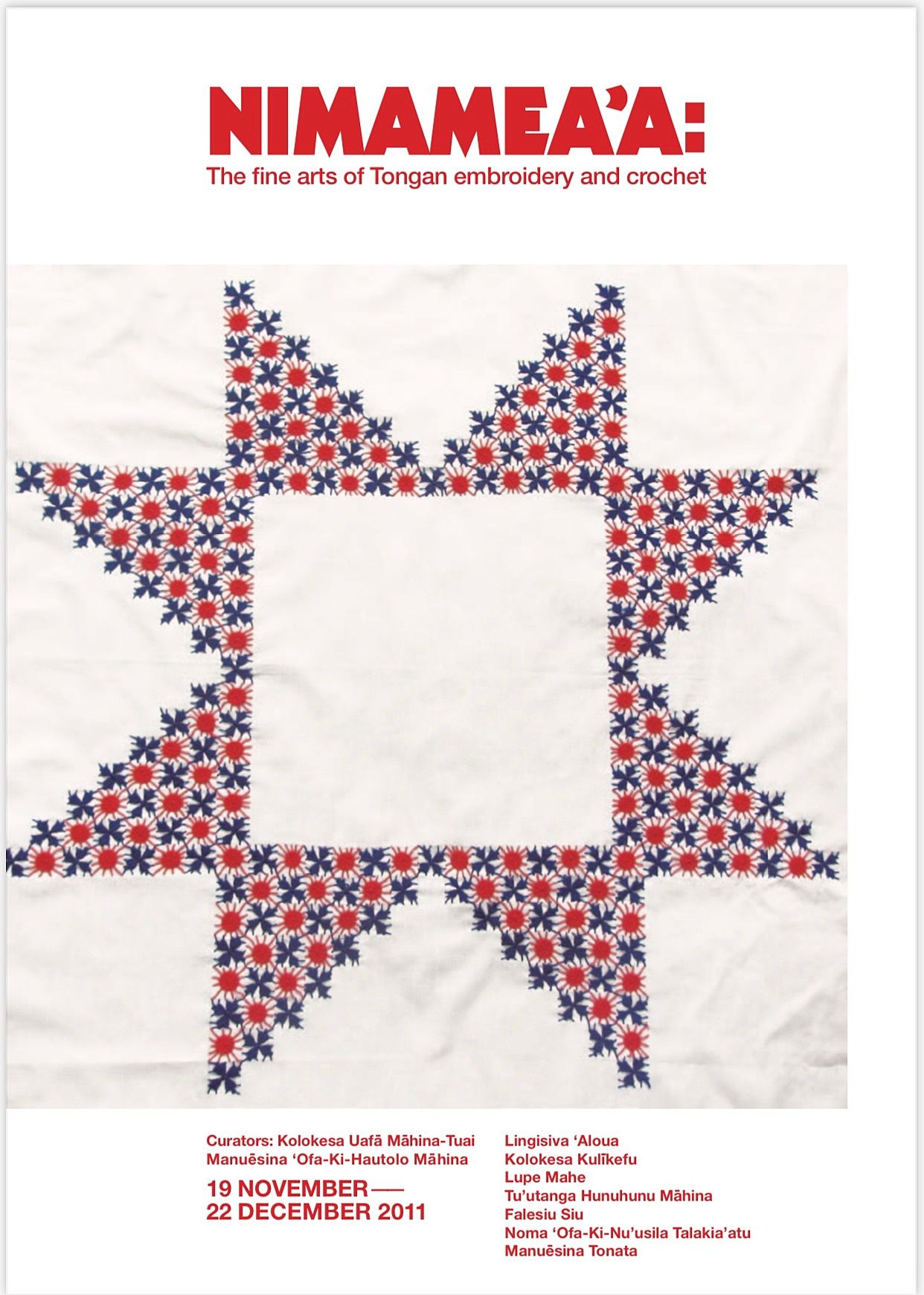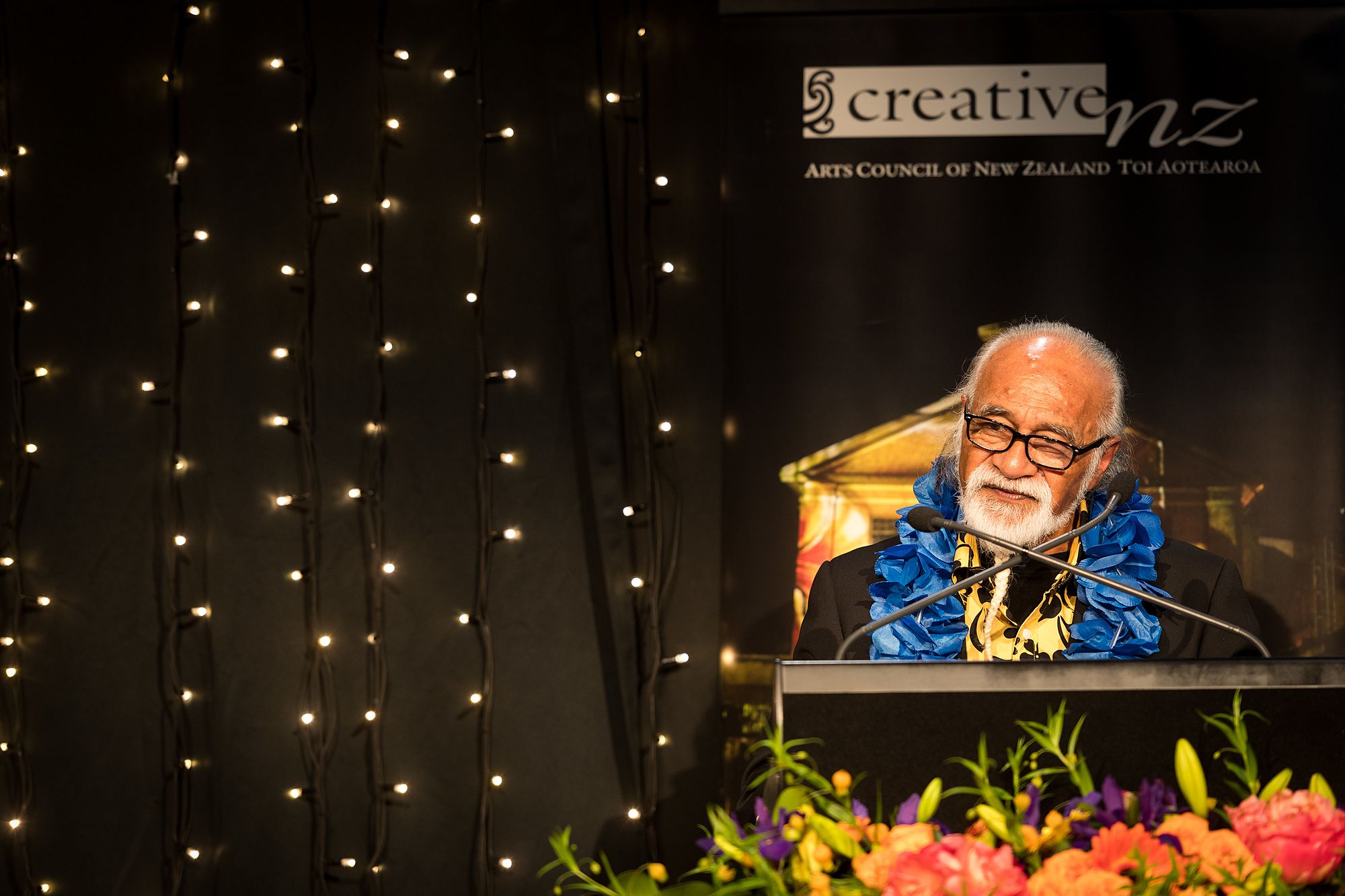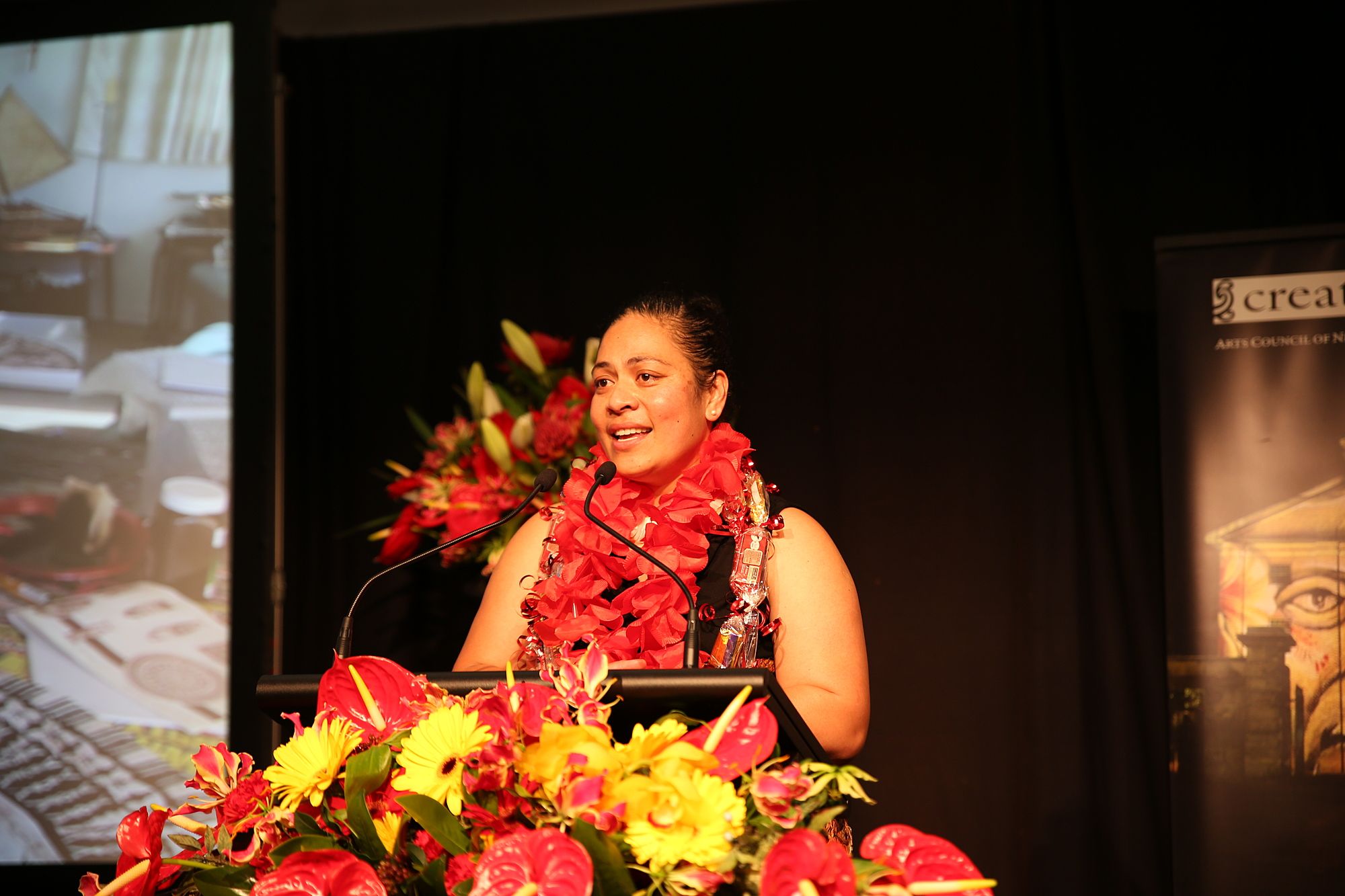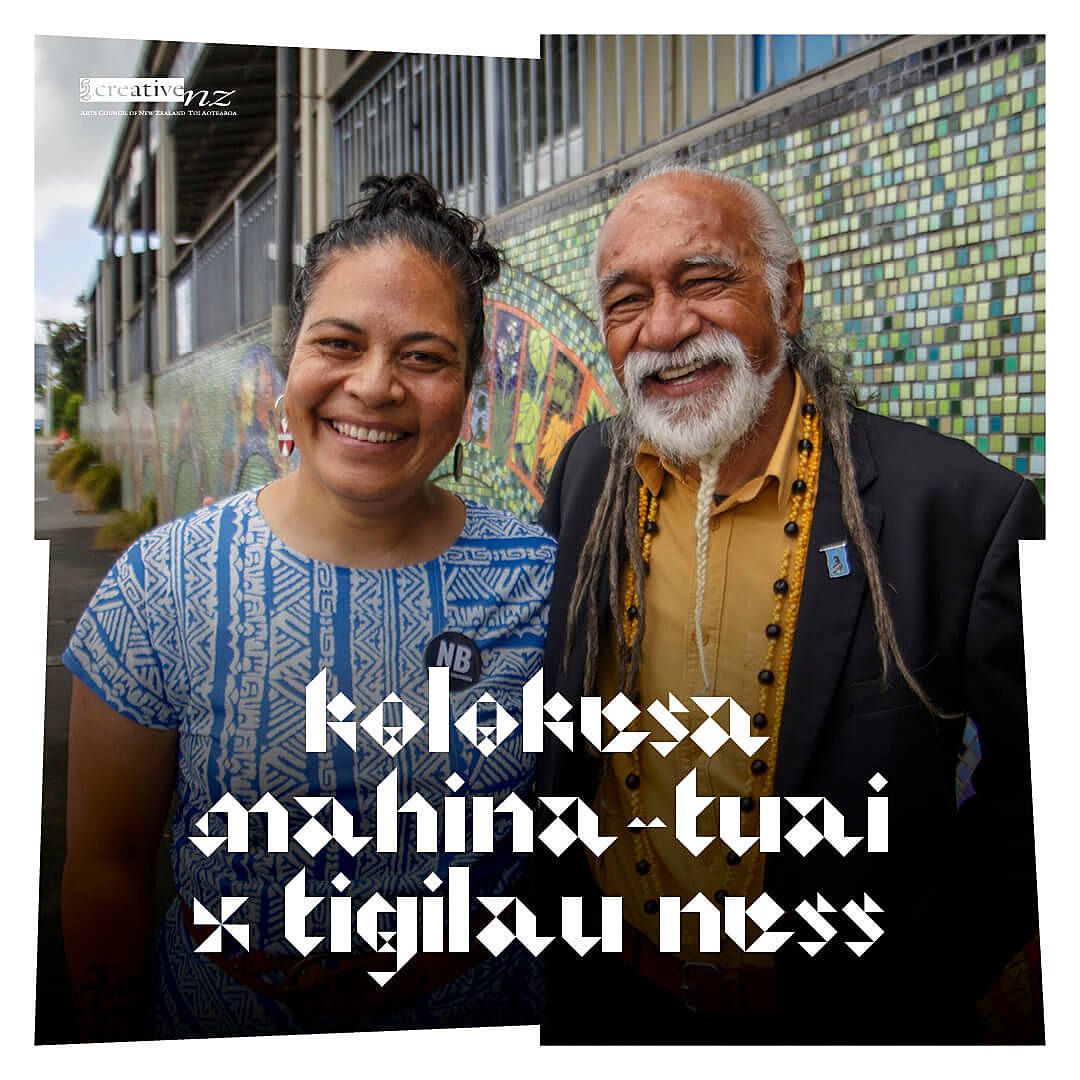United in our Diversity
A talanoa between Tigilau Ness and Kolokesa Uafā Māhina-Tuai on their personal reflections of Creative New Zealand’s Pacific Arts Committee of 2011 to 2014.
We’re collaborating with Creative New Zealand to bring you the groundbreaking Pacific Arts Legacy Project. Curated by Lana Lopesi as project Editor-in-Chief, it’s a foundational history of Pacific arts in Aotearoa as told from the perspective of the artists who were there.
This piece is a talanoa between Tigilau Ness and Kolokesa Uafā Māhina-Tuai of their time and space as artists on Creative New Zealand’s Pacific Arts Committee (PAC) from 2011 to 2014. They share their personal reflections and insights into their thinking, feeling and doing prior to, during and after being part of what became the last PAC before its legacy was formally disestablished on 1 May 2014 as the Arts Council moved into a unitary council structure.
Tigilau Ness: I am a first-generation Aotearoa New Zealand-born Niue. My parents migrated from Niue Island in 1950 and I was born in Auckland in 1955.
My time on the Creative New Zealand (CNZ) Pacific Arts Committee (PAC) was one of wonderment, excitement, fulfillment and of great learning. These feelings still exist in me today, and I feel honoured and privileged to have represented my beloved Niue while working with such an incredible team of arts practitioners and creative Pacific minds.
I was first invited by Makerita Urale, who was Senior Programme Advisor, Pacific Arts at the time, to show an expression of interest as the Niue representative to replace Whaea Matafetu, who had served her tenure.
Prior to the committee induction I was ‘brain fed’ on the processes and details of working on the PAC: the Toi Tōtara Haemata and Toi Uru Kahikatea investment programmes, what to expect, and what was expected of me should I accept and be accepted for the Niue representative position. I just soaked it all up. I was keen, and eager to start.
At that first-ever meeting with CNZ my burning question was, would I be accepted with my political activist history? Here I was, a member of the Polynesian Panther Party – the first multi-ethnic Polynesian political party in Aotearoa New Zealand – holding to account the position of Minister for Arts, Culture and Heritage. My activism was against racism and institutionalised racism in this country; I was involved in protests against the injustices of the Dawn Raid era committed against Pacific Island People; I took part in the 1975 Māori Land March, which led to arrests at the 1978 Bastion Point Māori Land occupation; and I was imprisoned following the anti-apartheid 1981 Springbok Tour protests. Would this not reflect negatively on my involvement in CNZ? I trusted Makerita. That was all I knew.
At 10.40am on Wednesday 3 August 2011, Pele Walker, Chair of the PAC, rang me and said I had got the appointment.
Here I was, a member of the Polynesian Panther Party, holding to account the position of Minister for Arts, Culture and Heritage.
Kolokesa Uafā Māhina-Tuai: I migrated to Aotearoa in 1982, at the age of six, to join my parents ‘Ōkusitino and Tu‘utanga Hunuhunu Māhina, who were already in Aotearoa.
Like Tigilau, I was also invited by Creative New Zealand to send in an expression of interest to become the Tongan representative on the PAC. In that time and space, I was actively involved in various arts organisations and projects. And there were major gaps in the knowledge, understanding and valuing of cultural practices and forms from our homelands that were continued and maintained by practitioners in Aotearoa. So I welcomed the advantages of being part of the PAC. Not only to serve my own Tongan community, but also to work collectively with my fellow PAC members to champion and effect some real and meaningful changes for the betterment of our wider Moana Oceania communities in Aotearoa.
Like Tigilau, I also confirmed my appointment to the PAC in August 2011 and our first official meeting was that November. The other members were Frances Hartnell (Cook Islands), Fuimaono Karl Pulotu-Endemann (Sāmoa), John Puka (Tokelau), Tigilau Ness (Niue), Marama T-Pole (née Papau, Tuvalu), and Pele Walker was our Chair.
TN: I remember at our meetings feeling that somehow both Pacific arts and Pacific artists were being underfunded and that there was a cap on our funding capability. It really was like fighting over scraps as to who would receive funding and who would miss out. I believe it was our individual talents and collective Pacific unity that helped us make the right decisions. We all wanted the best for our Pacific artists. We never fought amongst ourselves and were all happy and elated, emotionally and spiritually, after each deliberation, knowing that we had done our best for CNZ, represented our people, and accomplished an important task, together.
Fuioli Vakaniu (right) and Marama T-Pole (nee Papau, left) presenting at Mamas and Museums, 2011 South Auckland Pacific Arts Summit.
However, we were also mentally and physically drained, such was the intensity of concentration and enormity of the task. That is why today, many years later, I believe we still have that bond between us. CNZ and staff were conducive to that special feeling between us in the PAC. If that is how we were made to feel by CNZ, then the same can be done for our nation. Arts and culture will move the people forward. Together.
KUM-T: I must admit that I joined the PAC with a focused mission – to look critically at CNZ’s knowledge and understanding of ‘heritage’ arts and artists. This was largely to do with what was happening in the living environment and communities that I was working within and across.
I was on the Board of Tautai Contemporary Pacific Arts Trust (one of the key CNZ-funded Moana Oceania organisations), where my critique of inaccurate cultural content that was written for publication in their newsletter had created offence. My advocacy around a more holistic knowledge and understanding of Moana Oceania arts (so that creatives I was working with whose works were regarded as ‘heritage’ or ‘traditional’ and not ‘contemporary’ could benefit from Tautai’s services) was a challenge. And when I talked about the importance of our languages, I was asked what language had got to do with the arts! Despite being ostracised for talking critically about these issues, I was advised to complete my term on the Tautai Board and be the necessary ‘voice’ of accountability. So it was timely when I was approached to join the PAC, as it meant I had to leave the Tautai Board due conflict of interest. This was a critical move because it took my advocacy to that higher level, with the hopes of better informing the work of organisations like Tautai.
'Nimamea'a: The fine arts of Tongan embroidery and crochet' exhibition catalogue with detail of a Tupenu matala'i'akau. Embroidered sheet, made in 1996 by Manuēsina Tōnata.
There were two other projects that I was involved in that provided me with my staunch stance on the PAC. I had just rounded up a project called Mamas and Museums: Pacific Women’s Fine Arts and Museums Forum and Workshop, which was part of the 2011 South Auckland Pacific Arts Summit run by Ema Tavola in her capacity as the Pacific Arts Coordinator for Manukau City Council. One emphasis of this event was to showcase the innovation, creativity and ingenuity of the making practices of our wider Moana Oceania ‘Mamas’, and to highlight that they play a key role in maintaining and preserving our fine art forms yet are unknown in the mainstream arts world. The other project was with Objectspace, to deliver what I later found out was its first-ever wider Moana Oceania exhibition, called Nimamea‘a: The Fine Arts of Tongan Embroidery and Crochet, which I co-curated with Manuēsina ‘Ofa-Ki-Hautolo Māhina. This project was also to showcase and make visible the work of Tongan women fine artists, but most importantly to do so from a Tongan worldview of what art is.
As someone who was and is always critiquing the undervaluing of, and the problematic terminologies associated with, the ‘heritage’ arts and artists flag, a breakthrough was gifted through the words and wisdom of Tigilau Ness, beautifully articulated during one of our talanoa, in February 2013:
A tree may branch and grow in any number of directions, and if you water the roots the tree will grow. The heritage arts are the roots of all Pacific arts.
This was included in the Creative New Zealand Pacific Arts Review Final Report 2013, which was discussed at the May 2013 PAC meeting, with the Arts Council endorsing the recommendations from the Report in July 2013. One key recommendation was to “recognise a Pacific heritage arts key role within the Toi Tōtara Haemata investment programme.” And today there are two organisations that can champion the ‘heritage’ arts and artists’ voices and issues within and across CNZ – Pacific Dance New Zealand and Pacifica Mamas Arts & Cultural Trust (Pacific Arts Centre). They are both currently in the Toi Uru Kahikatea (Arts Development) investment programme – the former is a great advocate for the continuum of Moana Oceania performance arts, with the leadership of Iosefa Enari; and the latter covers all wider Moana Oceania artforms and media with their strong foundation laid by Mama Mary Ama and the Pacifica Mamas (and Papas!).
So, in reflecting back on the discussions that were had at the PAC table from 2011 to 2014, I share the same sentiments as Tigilau – we appreciate the true value behind ‘diversity in unity and our unity in diversity’. Our diversity – of nations, gender, different knowledges, expertise and experiences of our respective professions, and as individuals who are part of our diverse, living Moana Oceania communities in Aoteaora – united us under the work we carried out as members of the PAC. Our unity was strengthened because we considered the full diversity of perspectives that were tabled and discussed, until we reached a mutual knowledge and understanding of the best way forward collectively. With our respective communities always at the heart of our talanoa, we each carried out our PAC roles, contributions and critique in genuine service to them.
Tigilau Ness. Photo by Raymond Sagapolutele
TN: PAC Sāmoan Community Representative at the time, Fuimaono Karl Pulotu-Endemann rightly said, “The arts is the only arena in which Pacific people are not in the deficit.”1 It is true also, as was stated in the CNZ Pacific Arts Committee Recommendations to the New Unitary Council in 2014, that “it is imperative therefore that Creative New Zealand‘s structures and processes are fit for purpose, responsive to the needs of our communities, and continue to enable this advantage: for some Pacific people art is a vehicle for the expression of cultural pride and identity (and wellbeing), but for many it is the only vehicle.”2
I frequently saw similarities between PAC and my parent organisation, the Polynesian Panthers, and I would often consider (and still do) offering honorary membership to some members of the PAC. Such is the respect I have for the PAC, and of the kinship of our Pacific hopes and aspirations for this, our adopted country. Some of the PAC were wāhine toa (and still are today), unafraid to stand for all Pacific people and our rightful place in this society, even from within government institutions like CNZ. Fuimaono Karl Pulotu-Endemann was already fighting for our peoples’ rights in the mental health sector and the union movement. The Panthers, too, were doing this on a daily basis. Three of the major platforms that I adhere to today are: to peacefully eliminate all forms of racism; to celebrate Mana Pasifika; and to Educate to Liberate.
I frequently saw similarities between CNZ's Pacific Arts Committee and my parent organisation, the Polynesian Panthers
CNZ has and is taking on board the PAC recommendations of 2014 (it is a continual process) to the New Unitary Arts Council and has implemented some of these recommendations. It shows in the developing culture of CNZ. Tautoko, kia kaha.
KUM-T: The four recommendations we collectively submitted in our legacy paper were for the New Unitary Arts Council, under the National Government, before the formal disestablishment of the PAC on 1 May 2014. The PAC had been in existence for 20 years with Maualaivao Albert Wendt as its first Chair. Tigilau and I together with Chair Luamanuvao Winnie Laban (Sāmoa), Fuimaono Karl Pulotu-Endemann (Sāmoa), Marama T-Pole (née Papau, Tuvalu), Fuli Pereira (Tokelau) and Caren Rangi (Cook Islands) made up the last PAC. The New Unitary Arts Council had the requirement of two wider Moana Oceania representatives; we were excited that these positions were filled by two members of our last PAC, Luamanuvao Winnie Laban and Caren Rangi.
Over six years later, we are now into November 2020, and it is already proving to be a year that is like no other. We have been, and are currently, impacted physically, mentally and spiritually with the effects and affects of a global Covid-19 pandemic. On the one hand it has had detrimental impacts on the cultural sectors, but on the other hand the cultural sectors have been the beacon of hope. This has been through creatives doing what they do best by unleashing their creativity in innovative ways and in most cases fully utilising the technology at hand. We have seen funding organisations like CNZ become less bureaucratic and onerous in their requirements and processes to access funds. This year has also seen Caren Rangi made Deputy Chair of the Arts Council, and the creation of five new, wider Moana Oceania roles in CNZ. This is a massive change from 2014, when there was just the one dedicated wider Moana Oceania role.
I agree with Tigilau that it has been a continual process and journey in which some of the recommendations that the PAC made in 2014 have been, and are currently being, implemented; but there is still more work to do.
Our uniqueness as creative peoples lies in our cultural differences and nuances
TN: By 2022, when the true Aotearoa New Zealand History will finally be taught in schools, the PAC will also have its rightful place as an example of great aroha for the people of Aotearoa New Zealand. While PAC ceased to exist, the Committee membership has not ceased its interest in the continued success that Aotearoa New Zealand arts enjoy as the result of the achievements of Pacific artists and arts.
I’ve never looked back since. I threw myself into doing my best for the PAC: representing for Niue; fighting for the best outcomes for all Pacific artists; concentrating on all the finer details of their funding applications presented; committing time and effort into reading the thousands of pages of applications for arts projects and events that were absolutely amazing and wonderfully creative and representative of the Pacific arts that have enriched, entertained, educated and healed our beloved motu Aotearoa New Zealand. Every decision we made was collective and the right decision. Wonderful team, wonderful Chair. Good governance, CNZ.
KUM-T: It is a different context today, in which the disestablishment of the 20-year journey and legacy of the PAC, under a National Government, is continuing its journey into the ‘new normal’ that we will be moving into with Labour’s landslide victory, which took place on the evening of 17 October 2020. The Hon Carmel Sepuloni has also recently been announced as Aotearoa New Zealand’s Minister for Arts, Culture and Heritage. The PAC created a space where we were united in our differences, and our differences in turn enriched our talanoa through a process of mediating our multiple perspectives into a common goal for the creative wellbeing of our wider Moana Oceania communities. Placing the past in front of us to reflect on the process of ‘talking critically yet harmoniously’ that took place during our tenure from 2011 to 2014 has been useful in looking critically at the way this has informed CNZ’s present and future journey with its Pacific Arts Strategy 2018–2023.
Kolokesa Uafā Māhina-Tuai. Photo by Sarah Hunter
If we place the 20-year legacy of the PAC in front of us, as guidance on how to mediate the present status quo of the arts of Moana Oceania in Aotearoa, we will see that our uniqueness as creative peoples lies in our cultural differences and nuances. We then add the intergenerational and intercultural dynamic, with generations that are born and raised here in Aotearoa, many of whom are of multiple heritages. With a growing and youthful population, we have a responsibility to ensure that our younger minds and hearts maintain connections to the creative richness found in our own unique and different Indigenous ways of knowing, seeing and doing art.3
Today, cultural institutions including CNZ have the opportunity to bring more visibility and presence to our living creative communities, by valuing and utilising the wealth of our different cultural knowledges and understandings. This involves a shift in the axis, to changing mindsets, thinking, feeling and doing to provide a more balanced approach when representing us generally as wider Moana Oceania peoples in Aotearoa, by not neglecting the specifics of our 17 different nations within the wider region that we descend from. We will then disrupt what is happening now – with cultural organisations operating and accepting a status quo that defines wider Moana Oceania as ‘one’ people, with ‘one’ mind and ‘one’ way of knowing, seeing, doing and being – and start acknowledging that Moana Oceania is a ‘collective’ of peoples, with ‘many’ minds and ‘multiple’ ways of knowing, seeing, doing and being. The shift needs to take place in the minds and hearts of decisionmakers and policymakers at a government level, and within and across the cultural sector – to firstly know our differences, understand the strength and unity in our diversity, and reflect it back to us with more informed decisions and relevant policies. This is how we genuinely centre the living realities of our communities. And this is when transformational change occurs.
1 Quoted from the “CNZ Pacific Arts Committee Recommendations to the New Unitary Council”, which was sent with a letter on 18 April 2014 to Dr Richard Grant, Chair, Arts Council of Creative New Zealand from Caren Rangi on behalf of the Pacific Art Committee at the time: Luamanuvao Winnie Laban (Chair), Tigilau Ness, Fuimaono Karl Pulotu-Endemann, Kolokesa Māhina-Tuai, Marama Papau, Fuli Pereira and Caren Rangi.
2 Ibid.
3 See this link for more information on the research into the ‘arts’ of Moana Oceania, which engaged Moana Oceania holders of knowledge from nine island nations, who gifted the research with nine different examples of knowing, seeing and doing art from their respective Indigenous lenses.
cnz
This piece is published in collaboration with Creative New Zealand as part of the Pacific Arts Legacy Project, an initiative under Creative New Zealand’s Pacific Arts Strategy. Lana Lopesi is Editor-in-Chief of the project.
Series design by Shaun Naufahu, Alt group.
Header photo by Pati Solomona Tyrell.
